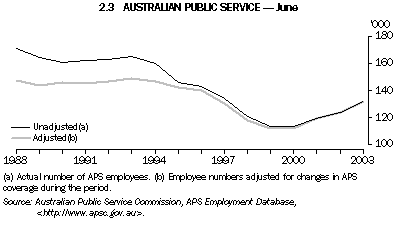The APS provides policy advice to the Australian Government and facilitates the delivery of programs to the community. The APS is part of the broader public sector, which includes parliamentary departments and staff, Australian-owned companies, statutory authorities, a separate public service for each of the states and territories, and local government employees. At June 2003 there were 131,711 employees in the APS (graph 2.3). This represents an 18% decline since 1994, but a 16% increase since June 2000.
There are currently 18 departments of state and around 60 statutory agencies. An updated list of these bodies can be found at <http://www.apsc.gov.au/>. Statutory agencies are responsible for a specific function prescribed within departments’ portfolio responsibilities. The Australian National Audit Office, for example, falls within the Department of Prime Minister and Cabinet and provides a range of audit services to the Parliament and Commonwealth public sector agencies. Each department is managed by a chief executive officer, or secretary, who is responsible to the relevant minister for the efficient, effective and ethical use of resources. The minister, in turn, takes political responsibility for the actions of the department. Departments and statutory agencies are governed by legislation specific to their functions, and by the Financial Management and Accountability Act 1997 (Cwlth). This Act states specific requirements for the management of human and financial resources. The 18 departments and a majority of statutory agencies are also subject to the Public Service Act 1999 (Cwlth) which require public servants to act responsively, accountably, impartially and with integrity. As well as answering to the relevant minister, the APS is accountable to the Australian community through a variety of mechanisms including parliamentary committees, administrative law, the Ombudsman and the Auditor-General.
Over the past two decades, the APS has undergone substantial change, both in its internal management processes and in its methods of service delivery. Examples of management changes include the introduction of accrual budgeting in the 1999-2000 Budget, an emphasis on reaching performance targets, the costing of government 'outputs', the imposition of capital use charges, the devolution of responsibility to departments and more flexible employment practices. Examples of changes to service delivery include the trend towards providing information and other services on the Internet, increased contracting of service delivery to the private sector and the establishment of customer service charters.
Public resources are harnessed by the public sector to give practical effect to government policies. Traditionally, this process has been known as public administration. Increasingly, it is known as public management, reflecting the growing expectation that public sector managers will take responsibility for achieving results, as well as the increasing emphasis on efficiency. Many APS agencies have developed systems of performance pay to encourage this focus on results.

 Print Page
Print Page